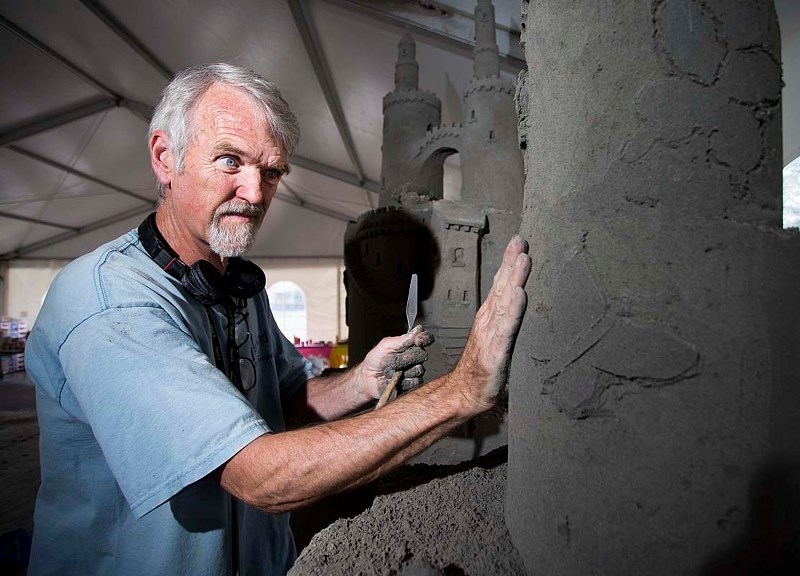Sand castles are the stuff of dreams along with dragons and fairy godmothers. So sturdy, yet so fragile they look as if they could vanish in a puff with a mere touch.
But the 34th annual International Children’s Festival is, if anything, a dream catcher that turns fantasy into reality.
Here in one of Canada’s chilliest provinces, we are used to seeing beautifully crafted snow and ice sculptures. Sand sculptures – not so much.
However this year, Peter Vogelaar, a multiple Canadian sand sculpting champion has been hired to sculpt a couple of castles – one that is six feet plus – with an invitation to let the public watch as they take shape.
The Kootenay-based sculptor is also hosting a series of children’s workshops where he not only shares secrets on building sandcastles, but also takes kids on an archeological dig, a road circuit and an African savannah.
Vogelaar’s sand box is 32 feet square and contains 40 tons of sand imported from Lake Wabamun. It has a grey tinge and from a distance looks like clay.
“There’s probably 10 tons of sand in the sculpture alone. That’s what keeps me fit – moving sand,” laughs the easy-going Vogelaar.
He explains that sand sculptors stay away from typical beach sand that if viewed under a microscope look like tiny balls eroded by wave action.
Instead he prefers working with gritty, angular shaped grains with flat plates that form a magnetic attraction when water is introduced.
“The sand forms an ionic band with the surface tension of water. It’s like when you have two plates of glass with water between them. If you try to take them apart, you can’t.”
Just by feeling the texture he estimates the Wabamun sand is in the world’s top two per cent. That’s pretty high accolades for a man who has sculpted in nine countries across North America and Europe as well as China, Japan, Korea, Taiwan, Kuwait and the Dominican Republic.
Vogelaar always followed his creative groove. For years, he and his wife operated a successful sign business in Fort St. John before moving to the warmer Kootenays nearly two decades ago.
“More than 20 years ago I got into snow sculpting. It was a new challenge for me. You could win championships but all you’d get is a handshake – no money.”
Back in 1992, Vogelaar and his wife Lesley Mayfield dabbled in artistic endeavours. They heard about the British Columbia Snow Sculpting Contest in Vernon offering a first prize ticket to the Quebec Winter Carnival.
Although novices, the duo undertook the challenge and won the People’s Choice award for their likeness of a polar bear stalking an Inuit hunter.
This would lead to participation in four Winter Olympics, Nagano (1998), Salt Lake City (2002), Torino (2006) Games and Vancouver (2010).
“We were commissioned to do snow sculptures at Whistler. We worked on the winged goddess Nike (Greek goddess of victory) and we reproduced the Olympic torch with sheep horns carved with aboriginal symbols.”
Twelve years ago, when fellow snow sculptors suggested Vogelaar try sand sculpting, he initially resisted.
“I thought it was too cartoony. I didn’t consider once I got there I could do anything I wanted.”
But by 2003, he teamed with David Ducharme and the duo won silver at Ottawa’s Canadian Sand Sculpting Competition.
“The hook for me was that if you paid your way going, you would get a free ticket back home on VIA Rail.”
With Ducharme, Vogelaar has won two world championships and numerous international contests. Flying solo, he has won the Canadian open four years in a row.
“After snow, sand is liberating. You carve what you like. A well-packed snow block has a strength of its own. It’s fantastic stuff. But sand, as soon as you take a tiny tool to it, it’s so delicate. The challenge for me, when I come to an event is never knowing what sand I will get and having to work with it.”




